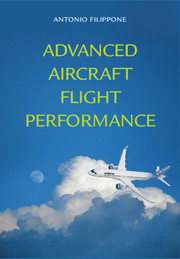Book contents
- Frontmatter
- Contents
- Tables
- Preface
- Nomenclature
- Technology Warning
- 1 Prolegomena
- 2 Aircraft Models
- 3 Weight and Balance Performance
- 4 Aerodynamic Performance
- 5 Engine Performance
- 6 Propeller Performance
- 7 Airplane Trim
- 8 Flight Envelopes
- 9 Take-Off and Field Performance
- 10 Climb Performance
- 11 Descent and Landing Performance
- 12 Cruise Performance
- 13 Manoeuvre Performance
- 14 Thermo-Structural Performance
- 15 Mission Analysis
- 16 Aircraft Noise: Noise Sources
- 17 Aircraft Noise: Propagation
- 18 Aircraft Noise: Flight Trajectories
- 19 Environmental Performance
- 20 Epilogue
- Appendix A Gulfstream G-550
- Appendix B Certified Aircraft Noise Data
- Appendix C Options for the FLIGHT Program
- Index
- References
13 - Manoeuvre Performance
Published online by Cambridge University Press: 05 January 2013
- Frontmatter
- Contents
- Tables
- Preface
- Nomenclature
- Technology Warning
- 1 Prolegomena
- 2 Aircraft Models
- 3 Weight and Balance Performance
- 4 Aerodynamic Performance
- 5 Engine Performance
- 6 Propeller Performance
- 7 Airplane Trim
- 8 Flight Envelopes
- 9 Take-Off and Field Performance
- 10 Climb Performance
- 11 Descent and Landing Performance
- 12 Cruise Performance
- 13 Manoeuvre Performance
- 14 Thermo-Structural Performance
- 15 Mission Analysis
- 16 Aircraft Noise: Noise Sources
- 17 Aircraft Noise: Propagation
- 18 Aircraft Noise: Flight Trajectories
- 19 Environmental Performance
- 20 Epilogue
- Appendix A Gulfstream G-550
- Appendix B Certified Aircraft Noise Data
- Appendix C Options for the FLIGHT Program
- Index
- References
Summary
Overview
This chapter deals with basic airplane manoeuvres, including flight in the vertical plane and in the horizontal plane. After an introductory description of these manoeuvres (§ 13.1), we start with powered turns (§ 13.2) and unpowered turns (§ 13.3); the latter turn essentially refers to glider-type vehicles, including soaring flight. Next, we introduce the manoeuvre envelope of the airplane (§ 13.4) and discuss pilot-related issues, such as sustainable g-loads. Roll performance (§ 13.5) is one example of manoeuvre on a straight line by a high-performance aircraft, and pull-up (§ 13.6) is one example of flight path in the vertical plane. Finally, we discuss aircraft flight in a downburst (§ 13.7).
KEY CONCEPTS: Powered Turns, Banked Turns, Minimum-Fuel Turn, Turn Rates, Cornering Speeds, Unpowered Turns, Manoeuvre Envelopes, V-n Diagram, Sustainable g-Loads, Roll Performance, Pull-Up Manoeuvre, Downbursts.
Introduction
The term manoeuvre refers to any change of the flight path. There are at least three basic types of manoeuvres: 1) a turn in the horizontal plane, when the aircraft changes heading and banks on one side (lateral manoeuvre); 2) a turn in a vertical plane, when the aircraft increases or decreases its altitude (pull-up and pull-out); and 3) a roll around the aircraft's longitudinal axis, when the aircraft rotates around itself whilst following a straight flight path (longitudinal manoeuvre).Many complex manoeuvres can be reduced to a combination of these.
During a turn on the horizontal plane, the aircraft gradually changes its banking angle from zero to a maximum and then back to zero.
- Type
- Chapter
- Information
- Advanced Aircraft Flight Performance , pp. 360 - 391Publisher: Cambridge University PressPrint publication year: 2012



